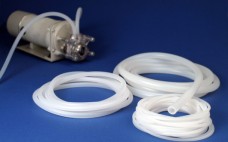Human mesenchymal stem cells (hMSCs) are a self-renewing population of adherent, multipotent progenitor cells that can differentiate into several lineages. The current definition of MSCs includes adherence to standard tissue culture plastic ware, expression of various surface antigens, and multilineage in vitro differentiation potential (osteogenic, chondrogenic, and adipogenic). hMSCs hold great promise as therapeutic agents because of their potential ability to replace damaged tissue and their immunomodulatory properties. Consequently, many clinical trials using hMSCs are currently under way in a…
Upstream Processing
A Statistical Approach to Expanding Production Capacity
Contract manufacturer DSM Biologics — at its current good manufacturing practices (CGMP) facility in Groningen, The Netherlands — provides services for clinical development and commercial production based on mammalian cell culture technology (Photo 1). During the 2011–2012 year, the facility went through a major expansion project to enlarge its capacity and fulfill a growing customer demand. From a business point of view, the project had a well-defined target for future production capacity as well as investment volume. Photo 1: Photo…
Advocating an Evolution
In a 2006 report, the US Department of Health and Human Services hailed regenerative medicine as “the vanguard of 21st century healthcare” and “the first truly interdisciplinary field that utilizes and brings together nearly every field in science” (1). To fuel support for regulatory, legislative, and reimbursement initiatives in this new therapeutic class, a small group of scientists, life science business executives, patient advocates, and other experts formed the Alliance for Regenerative Medicine (ARM, http://alliancerm.org). Starting with 17 charter members,…
Implementation of Quality By Design in Vaccine Development
At the IBC Third Annual International Forum on Vaccine Production, I presented an outline of “Best Practices for Quality by Design (QbD) in Biological Products and How to Implement in Vaccines.” It covered process development and QbD principles, best practices used in biologics, how QbD fits in with process validation, how it applies to vaccines, and some thoughts on the potential for seasonal vaccines. Shifts in Process Development Classic process development (as practiced in the early days) generally involved rudimentary…
Antibodies, Bioassays, and Cells
It’s no surprise that immunochemistry forms a broad and solid basis of biopharmaceutical analytical laboratory work. Immunochemicals include antibiotics and antigens, nucleic acids and nucleotides, enzymes, lipids, antioxidants, probes and dyes, and proteins and peptides. Available from companies such as Advanced Immunochemical, Immundiagnostik, Lampire Biological Laboratories, and Rockland Antibodies and Assays, their many uses include antibody isotyping and fragmentation. Adjuvants, buffers, assay kits, target biomolecules, and phage-display systems support those applications. Because background and off-target effects complicate the study of…
Protein Scaffolds
The recent success of monoclonal antibodies (MAbs) as therapeutic agents to treat cancer, multiple sclerosis, rheumatoid arthritis, and other chronic inflammatory and autoimmune disorders (Table 1) has catapulted these once difficult-to-develop molecules to the forefront of modern molecular medicine (1, 2). The size of the global MAb market in 2008 was valued at almost US$28 billion. Industry analysts predict that the size of the MAb market will grow to almost $68 billion by 2015, with the largest growth occurring in…
Evaluation of a New Single-Use UV Sensor for Protein A Capture
As the adoption of single-use systems continues to expand beyond bags and tubing to complete process steps, a full range of sensing technologies will be needed to complement the resulting varied single-use applications. Single-use sensors must meet or exceed the performance of traditional sensing technologies in areas such as accuracy, response time, ease of use, control system integration, process compatibility, regulatory requirements, and cost. Single-use flow-through process sensors are currently available for pressure, temperature, flow, and conductivity. Here, we report…
Vendor Voices: Flexible Manufacturing
One strong take-away message from BPI’s flexible facilities supplement (December 2012) is that there is no single road to achieving a flexible manufacturing process. The ability to quickly modify a unit operation, process line, or entire facility to accommodate change certainly depends on several factors. Flexibility is no longer exclusively linked to single-use systems for one specific operation. It connects facility design, staffing models, and revamped technologies. Vendors and suppliers are hearing first-hand what the industry wants in flexible operations.…
Ten Tips for Single Use Pharmaceutical Tubing Selection
Tubing for pharmaceutical and bioprocess applications has requirements involving sterilization, extractables, ingredients, flexibility, and performance. This paper offers suggestions on how to narrow your selection.
A High-Yielding, CHO-K1–Based Transient Transfection System
Biotherapeutics have emerged as effective treatments for many diseases. It’s estimated that every year hundreds of new biotherapeutic candidates enter development (1). Stable transfection of host cells to establish high-producing cell lines is the approved method for generating clinical-grade recombinant biologics. However, biotechnology companies needing to speed up their developmental timelines are increasingly relying on material generated using transient transfection (1, 2). Unlike stable gene expression (SGE) that requires several months of laboratory and process work, transient gene expression (TGE)…

